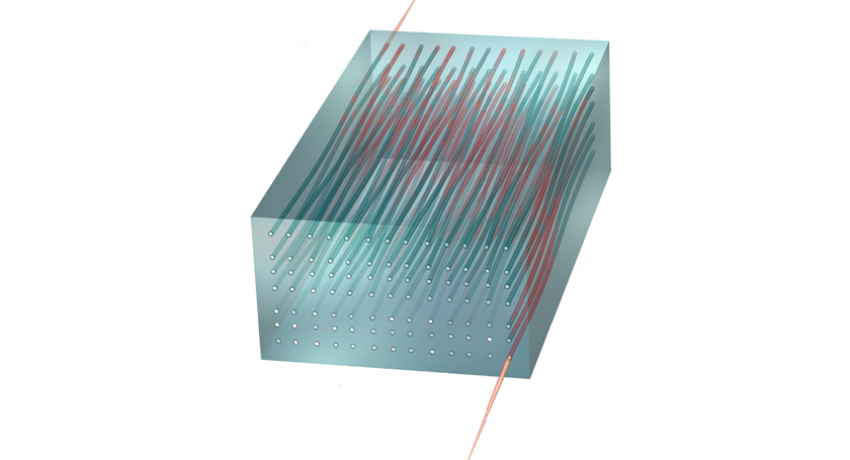Illustration of light passing through a two-dimensional waveguide array. Each waveguide is essentially a tube, which behaves like a wire for light, inscribed through high-quality glass using a powerful laser. Many of these waveguides are inscribed closely spaced through a single piece of glass to form the array. Light that flows through the device behaves precisely according to the predictions of the four-dimensional quantum Hall effect. Image: Rechtsman Laboratory, Penn State
For the first time, physicists have built a two-dimensional experimental system that allows them to study the physical properties of materials that were theorized to exist only in four-dimensional space. An international team of researchers from Penn State, ETH Zurich in Switzerland, the University of Pittsburgh, and the Holon Institute of Technology in Israel have demonstrated that the behavior of particles of light can be made to match predictions about the four-dimensional version of the “quantum Hall effect” — a phenomenon that has been at the root of three Nobel Prizes in physics — in a two-dimensional array of “waveguides.”
A paper describing the research appears Jan. 4 in the journal Nature, along with a paper from a separate group from Germany that shows that a similar mechanism can be used to make a gas of ultracold atoms exhibit four-dimensional quantum Hall physics as well.
“When it was theorized that the quantum Hall effect could be observed in four-dimensional space,” said Mikael Rechtsman, assistant professor of physics and an author of the paper, “it was considered to be of purely theoretical interest because the real world consists of only three spatial dimensions; it was more or less a curiosity. But, we have now shown that four-dimensional quantum Hall physics can be emulated using photons — particles of light — flowing through an intricately structured piece of glass — a waveguide array.”
When electric charge is sandwiched between two surfaces, the charge behaves effectively like a two-dimensional material. When that material is cooled down to near absolute-zero temperature and subjected to a strong magnetic field, the amount that it can conduct becomes “quantized” — fixed to a fundamental constant of nature, and cannot change. “Quantization is striking because even if the material is ‘messy’ — that is, it has a lot of defects — this ‘Hall conductance’ remains exceedingly stable,” said Rechtsman. “This robustness of electron flow — the quantum Hall effect — is universal and can be observed in many different materials under very different conditions.”

